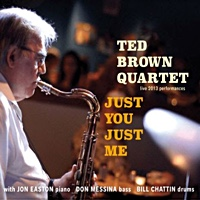Home » Jazz Articles » Profile » Erroll Garner: 100th Birthday Anniversary Of The Immorta...
Erroll Garner: 100th Birthday Anniversary Of The Immortal Swinging Maestro Of Jazz Piano
The '50s brought the advent of "cool jazz" with Miles Davis leading the way with a modal change on Birth of the Cool (Blue Note, 1957), Milestones ( Sony, 1958), and the seminal Kind of Blue (Columbia, 1959). With stellar casts of musicians, there were suddenly jazz recordings becoming million-sellers.
Along with Kind of Blue, pioneering jazz pianist Dave Brubeck and his compositional partner and sublime alto saxophonist Paul Desmond released Time Out (Columbia, 1959). Brubeck's release—with a subtle blend of cool and west coast jazz boosted by their now timeless hit "Take Five"—became one of the first jazz albums to sell a million copies.
Following on these musical coattails, jazz saxophone master Stan Getz and Brazilian guitarist Joao Gilberto brought the sexy beat of Brazilian Bossa Nova to the U.S. on Getz/Gilberto (Verve, 1964), which sold over two million albums by 1968.
But often left out of this esteemed company and running ahead of these timetables, Garner's milestone 1955 live recording Concert by the Sea sold over a million dollars' worth of retail copies by 1958. In the opinion of critic Scott Yanow, "this is the album that made such a strong impression that Garner was considered immortal from then on."
Standing on a distinctive style, incorporating stride-to-swing playing, rearranging popular songs and adding amazing chordal rhythm with spontaneous keyboard runs, Garner held his audience until the final flourish. With sophistication in composition and technique, his mainstay ballads were rich with melody, and his sets always had that signature "swing" beat in his repertoire. As further explained by Yanow, "Garner often stated the beat with his left hand like a rhythm guitar, while his right hand played chords slightly behind the beat." Garner's unique sound and always "happy" disposition (as fondly referred to by other jazz musicians), accentuated with audible grunts, created a loyal audience throughout a very in-demand lifetime of performance.
Never learning to read music, he had a superb musical memory. As John S. Wilson related in his 1977 New York Times obituary for Garner, after attending a Carnegie Hall performance by Russian classical pianist Emil Gilels, Garner rushed home to his apartment and played a large portion of the music from recall. When asked why he had never learned to read music, Garner was fond of replying, "No one can hear you read."
Born in Pittsburgh, Pennsylvania, in 1921, Garner started to play piano at the age of three, had an exceptional ear and would be mostly self-taught except for a few early years of lessons. According to biographical accounts, at age seven he began appearing on radio station KDKA with a group called the Candy Kids. By 11, he was playing on the Allegheny riverboats. He would initially be overshadowed by his older brother Linton, an accomplished jazz pianist who would go onto play with luminaries including Fletcher Henderson before World War II and later with Billy Eckstine and Dizzy Gillespie and also providing piano accompaniment for legendary jazz performers like Sarah Vaughan and Nat King Cole.
Erroll Garner began his professional career with a move to New York City in 1944. When Blue Note Records subsequently issued the five-volume Overture by Dawn (Blue Note, 1953) series, his compositions would begin to receive significant attention, and his recording career advanced. He would also briefly connect with the epicenter of bebop by playing with Charlie Parker's quartet on "Cool Blues" in 1947.
Breaking through to a much larger audience occurred with the famed Concert by the Sea recording in 1955, including bassist Eddie Calhoun and drummer Denzil Best. Recorded live in Carmel, California, at the Sunset Center—a venue that would evolve into the Monterey Jazz Festival—the record became the best-selling jazz album of its day. Reviewers recalled a "magic" that had transpired that evening. Listening to this performance today, there is a sense of Garner feeding off the audience, who in turn react to what they are hearing with spontaneous applause.
On Contrasts (Verve, 1954), Garner would record "Misty," which would become his signature composition and a hit on radio, crossing over to popular music charts through covers by Johnny Mathis, Ella Fitzgerald, Frank Sinatra, Sarah Vaughan and Aretha Franklin.
Garner would tour widely throughout his career, establishing an audience both in the United States and in Europe through the '60s and '70s. In the U.S., his fame was furthered by the new medium of television, with Garner often appearing on The Tonight Show (reportedly Johnny Carson's favorite jazz musician) and additional appearances on other popular evening formats hosted by Flip Wilson and Ed Sullivan.
He remained remarkably prolific between a busy touring schedule. Garner scored the music for the 1963 film A New Kind of Love and released That's My Kick in 1967 (RCA Studios). His single "Misty" was featured prominently in the 1971 thriller Play Misty for Me. Garner then released Gemini (RCA Studios, 1971), Magician (Capitol Studios, 1974), and the double album Play It Again Erroll (Columbia, 1975).
Failing health forced Garner to stop touring in 1975. He was soon diagnosed with lung cancer. He died on January 2, 1977, at the age of 55.
Paul Conley is an author, radio host and award-winning jazz and news broadcaster for NPR who produced a biographical profile of Garner. He wrote, "There exists in Erroll Garner's playing an emotional infectiousness from which no one with the slightest affinity for music is immune... Listen to any Erroll Garner recording and you realize, above all else, this man loved to play piano. If you were lucky enough to see him, you also know he loved to share that joy with his audience."
Jazz pianist and composer Billy Taylor told Conley, "[Garner] was able to be tremendously popular without compromising his integrity as a musician." Conley added, "Such is the joy of a genius."
Beyond the deserved accolades are Garner's words from a 1969 interview with musician and author Arthur Taylor—available in the book from Notes and Tones: Musician-to-Musician Interviews (De Capo Press, 1977)—Garner spoke about his creative drive, aversion to playing note-for-note and his desire to always seek other interpretations.
"I'm always looking for something new. As I can't read music, I don't have to say to myself, 'this is an arrangement I wrote six months ago, and I have to play it note for note.' I get as close as I can. Each time I play 'Misty'—and I play 'Misty' I would say a thousand times a year—I add a little something. I feel that if you liked it last night and you come back to hear me tonight, maybe I can do it better. At the same time, I'm creating, and it's not becoming a bore because of sticking to one certain pattern."
Coinciding with other events celebrating the Erroll Garner centenary, the double box set Erroll Garner Jazz Project released in June 2021 has also unearthed additional live recordings that further establish the seminal artistry, composition and innovation of this keyboard master. Internationally renowned jazz drummer and NEA Jazz Master Terri Lyne Carrington writes in the accompanying essay, "The discovery of this concert recording helps us to clearly understand that Garner's interpretive freedom of rhythm and melody, combined with his command of the instrument, made him lightyears ahead of his time."
Tags
PREVIOUS / NEXT
Support All About Jazz
 All About Jazz has been a pillar of jazz since 1995, championing it as an art form and, more importantly, supporting the musicians who make it. Our enduring commitment has made "AAJ" one of the most culturally important websites of its kind, read by hundreds of thousands of fans, musicians and industry figures every month.
All About Jazz has been a pillar of jazz since 1995, championing it as an art form and, more importantly, supporting the musicians who make it. Our enduring commitment has made "AAJ" one of the most culturally important websites of its kind, read by hundreds of thousands of fans, musicians and industry figures every month.
























